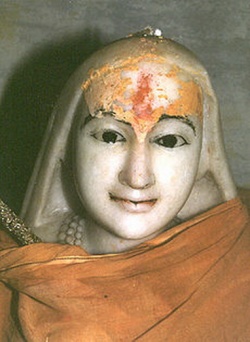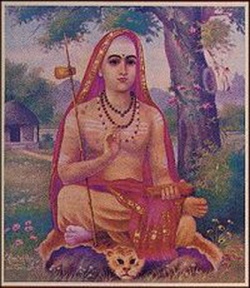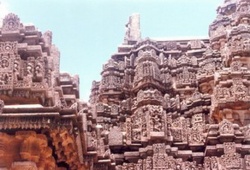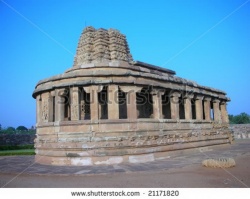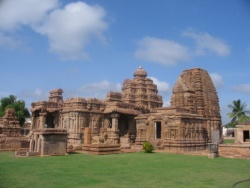Vedanta
Vedanta (/vɪˈdɑːntə/; Hindustani pronunciation: (ʋeːd̪aːn̪t̪), Devanagari: वेदान्त, Vedānta) was originally a word used in Hindu philosophy as a synonym for that part of the Veda texts also known as the Upanishads.
The name is a morphophonological form of Veda-anta = "Veda-end" = "the appendix to the Vedic hymns". It is also speculated that "Vedānta" means "the purpose or goal of the Vedas". Vedanta can also be used as a noun to describe one who has mastered all four of the original Vedas.
By the 8th century, the word came to be used to describe a group of philosophical traditions concerned with the self-realisation by which one understands the ultimate nature of reality (Brahman).
In this respect Vedānta is also called Uttarā Mīmāṃsā, or the 'latter enquiry' or 'higher enquiry', and is often paired with Purva Mīmāṃsā, the 'former enquiry'. Pūrva Mimamsa, usually simply called Mimamsa, deals with explanations of the fire-sacrifices of the Vedic mantras (in the Samhita portion of the Vedas) and Brahmanas, while Vedanta explicates the esoteric teachings of the Āraṇyakas (the "forest scriptures"), and the Upanishads, composed from the 9th century BCE until modern times.
Vedanta is not restricted or confined to one book and there is no sole source for Vedāntic philosophy.
History
Further information: Historical Vedic religion#Philosophy
In earlier writings, Sanskrit 'Vedānta' simply referred to the Upanishads, the most speculative and philosophical of the Vedic texts. However, in the medieval period of Hinduism, the word Vedānta came to mean the school of philosophy that interpreted the Upanishads. Traditional Vedānta considers scriptural evidence, or shabda pramāna, as the most authentic means of knowledge, while perception, or pratyaksa, and logical inference, or anumana, are considered to be subordinate (but valid).
The systematization of Vedāntic ideas into one coherent treatise was undertaken by Badarāyana in the Vedānta Sutra which was composed around 200 BCE The Vedānta-sūtra are known by a variety of names, including
(1) Brahma-sūtra,
(2) Śārīraka,
(3) Vyāsa-sūtra,
(4) Bādarāyaṇa-sūtra,
(5) Uttara-mīmāṁsā and
(6) Vedānta-darśana
The cryptic aphorisms of the Vedanta Sutras are open to a variety of interpretations, resulting in the formation of numerous Vedanta schools, each interpreting the texts in its own way and producing its own sub-commentaries. Consistent throughout Vedanta, however, is the exhortation that ritual be eschewed in favor of the individual's quest for truth through meditation governed by a loving morality, secure in the knowledge that infinite bliss awaits the seeker. Nearly all existing sects of Hinduism are directly or indirectly influenced by the thought systems developed by Vedantic thinkers. Hinduism to a great extent owes its survival to the formation of the coherent and logically advanced systems of Vedanta.
Source texts
All forms of Vedānta are drawn primarily from the Upanishads, a set of philosophical and instructive Vedic scriptures. "The Upanishads are commentaries on the Vedas, their putative end and essence, and thus known as Vedānta or "End of the Veda". They are considered the fundamental essence of all the Vedas and although they form the backbone of Vedanta, portions of Vedantic thought are also derived from some of the earlier āranyakas.
The primary philosophy captured in the Upanishads, that of one absolute reality termed as Brahman is the main principle of Vedanta. The sage Vyāsa was one of the major proponents of this philosophy and author of the Brahma Sūtras based on the Upanishads. The concept of Brahman – the eternal, self-existent, immanent and transcendent Supreme and Ultimate Reality which is the divine ground of all Being - is central to most schools of Vedānta. The concept of God or Ishvara is also there, and the Vedantic sub-schools differ mainly in how they identify God with Brahman.
The contents of the Upanishads are often couched in enigmatic language, which has left them open to various interpretations. Over a period of time, several scholars have interpreted the writings in Upanishads and other scriptures like Brahma Sutras according to their own understanding and the need of their time.
There are a total of six important interpretations of these source texts, out of which, three (Advaita, Vishishtadvaita and Dvaita) are prominent, both in India and abroad. These Vedantic schools of thought were founded by Shri Adi Shankara, Shri Ramanuja and Shri Madhvacharya, respectively. However, the Indian pre-Shankara Buddhist writer, Bhavya, in the Madhyamakahrdaya Kārika describes the Vedānta philosophy as "Bhedabheda". Proponents of other Vedantic schools continue to write and develop their ideas as well, although their works are not widely known outside of smaller circles of followers in India.
While it is not typically thought of as a purely Vedantic text, the Bhagavad Gita has played a strong role in Vedantic thought, with its representative syncretism of Samkhya, Yoga, and Upanishadic thought. Indeed, it is itself called an "upanishad" and thus, all major Vedantic teachers (like Shankara, Rāmānuja, and Mādhvāchārya) have taken it upon themselves to compose often extensive commentaries not only on the Upanishads and Brahma Sutras, but also on the Gita. In such a manner, Vedāntists both old and new have implicitly attested to the Gitā's importance to the development of Vedantic thought and practice. the veda
Advaita Vedanta (IAST Advaita Vedānta; Sanskrit: अद्वैत वेदान्त (əd̪ʋait̪ə ʋeːd̪ɑːnt̪ə]) was propounded by Adi Shankara and his grand-guru Gaudapada, who described Ajativada. It is the sub-school of the Vedānta (literally, end or the goal of the Vedas, Sanskrit) school of Hindu philosophy. In the school of Vedānta, Brahman is the only reality, and the world, as it appears, is illusory. As Brahman is the sole reality, it cannot be said to possess any attributes whatsoever.
An illusory power of Brahman called Māyā causes the world to arise. Ignorance of this reality is the cause of all suffering in the world and only upon true knowledge of Brahman can liberation be attained. When a person tries to know Brahman through his mind, due to the influence of Māyā, Brahman appears as God (Ishvara), separate from the world and from the individual. In reality, there is no difference between the individual soul jīvātman (see Atman) and Brahman. Liberation lies in knowing the reality of this non-difference (i.e. a-dvaita, "non-duality"). Thus, the path to liberation is finally only through knowledge (jñāna).
Dvaitādvaita
Śrī Nimbārkācārya
Dvaitādvaita was propounded by Nimbārka, based upon an earlier school called Bhedābheda, which was taught by Bhāskara. According to this school, the jīvātman is at once the same and yet different from Brahman. The jiva relation may be regarded as dvaita from one point of view and advaita from another. In this school, God is visualized as Krishna.
Vishishtadvaita
Vishishtadvaita was propounded by Rāmānuja and says that the jīvātman is a part of Brahman, and hence is similar, but not identical. The main difference from Advaita is that in Visishtadvaita, the Brahman is asserted to have attributes (Saguna brahman), including the individual conscious souls and matter. Brahman, matter and the individual souls are distinct but mutually inseparable entities. This school propounds Bhakti or devotion to God visualized as Vishnu to be the path to liberation. Māyā is seen as the creative power of God.
Sri Lakshmi Visishtadvaita
Sri Lakshmi Visishtadvaita was propounded by Sri Srinivasa Deekshitulu (950 A.D.) and this is primarily related to Vaikhanasa School of thought (based on Taittiriya Aranyaka) based on Badarayana Sariraka Sutras. This is something unknown to many of the scholars of today, that there is one such school of thought and it is strictly followed by the original priests of the celebrated ancient Tirumala Hill Shrine even to this day. It proposes that Brahman can be in sakala and nishkala forms. To meditate on the nishkala aspect of Brahman, the starting point is sakala (with attributes).
This school propounds 'Archana' (Worship), supplemented by 'Jnana' (knowledge) and 'Bhakti' (devotion) to be the path to liberation. In this school of thought the ultimate Brahman is Lord Vishnu along with goddess Lakshmi. Lord Vishnu must be worshipped along with Goddess Lakshmi. Tirumala Kshetram is one of the best examples of the implementation of the 'Sri Lakshmi Visishtadvaitam'.
Dvaita
Dvaita was propounded by Madhwāchārya. It is also referred to as tatvavādā - The Philosophy of Reality. It identifies God with Brahman completely, and in turn with Vishnu or his various incarnations like Krishna, Narasimha, Srinivāsa etc. In that sense it is also known as sat-vaishnava philosophy to differentiate from the Vishishtadvaita school known by sri-vaishnavism. It regards Brahman, all individual souls (jīvātmans) and matter as eternal and mutually separate entities.
This school also advocates Bhakti as the route to sattvic liberation whereas hatred (Dvesha)-literally 'twoness') and indifference towards the Lord will lead to eternal hell and eternal bondage respectively. Liberation is the state of attaining maximum joy or sorrow, which is awarded to individual souls (at the end of their sādhana), based on the souls' inherent and natural disposition towards good or evil.
The achintya-adbhuta shakti (the immeasurable power) of Lord Vishnu is seen as the efficient cause of the universe and the primordial matter or prakrti is the material cause. Dvaita also propounds that all action is performed by the Lord energizing every soul from within, awarding the results to the soul but Himself not affected in the least by the results.
Shuddhādvaita
Vallabhacharya
Shuddhadvaita was propounded by Vallabha. This system also identifies Bhakti as the only means of liberation, 'to go to Goloka' (lit., the world of cows; the Sankrit word 'go', 'cow', also means 'star'). The world is said to be the sport (līlā) of Krishna, who is Sat-Chit-Ananda or, "eternal bliss mind".
Story of Vedanta
There is a story in Mundaka Upanishad that runs like this: Once in a tree there were two birds, one at the upper branch, serene, majestic and divine, and the other at a lower branch, restlessly pecking fruits, sometimes sweet sometimes bitter. Every time, when the restless bird ate a bitter fruit, it looked at the upper bird and climbed a branch up. This occurred a number of times and eventually the bird reached the topmost branch. There it was not able to differentiate itself from the divine bird, and then it learned that there was only one bird in the tree, the upper bird, which is described as divine, the real form of the other restless bird. This is the thought of Vedanta. The fruits in the story are Karma, the restless bird denotes a human soul, and the majestic bird denotes the Absolute.
Comparison to Western philosophies
Similarities between Vedanta and Western philosophical traditions have been discussed by many authorities.
The 19th-century German Sanskritist Theodore Goldstücker was one of the early figures to notice the similarities between the religious conceptions of the Vedanta and those of the Dutch Jewish philosopher Baruch Spinoza, writing that Spinoza's thought was
... a western system of philosophy which occupies a foremost rank amongst the philosophies of all nations and ages, and which is so exact a representation of the ideas of the Vedanta, that we might have suspected its founder to have borrowed the fundamental principles of his system from the Hindus, did his biography not satisfy us that he was wholly unacquainted with their doctrines...
We mean the philosophy of Spinoza, a man whose very life is a picture of that moral purity and intellectual indifference to the transitory charms of this world, which is the constant longing of the true Vedanta philosopher... comparing the fundamental ideas of both we should have no difficulty in proving that, had Spinoza been a Hindu, his system would in all probability mark a last phase of the Vedanta philosophy.
Max Müller, in his lectures, noted the striking similarities between Vedanta and the system of Spinoza, saying "the Brahman, as conceived in the Upanishads and defined by Sankara, is clearly the same as Spinoza's 'Substantia'." Helena Blavatsky, a founder of the Theosophical Society also compared Spinoza's religious thought to Vedanta, writing in an unfinished essay "
As to Spinoza’s Deity—natura naturans—conceived in his attributes simply and alone; and the same Deity—as natura naturata or as conceived in the endless series of modifications or correlations, the direct outflowing results from the properties of these attributes, it is the Vedantic Deity pure and simple."
The German philosopher Arthur Schopenhauer drew explicit parallels between his philosophy, as set out in 'The World as Will and Representation', and that of the Vedanta philosophy ascribed to Vasya in the work of Sir William Jones.
==Source==
